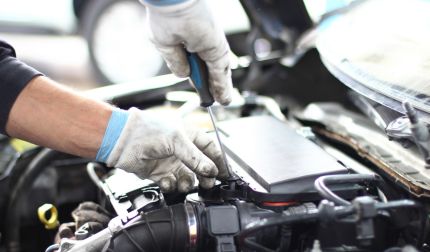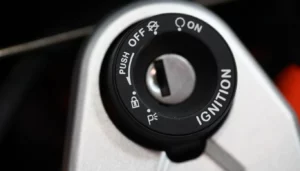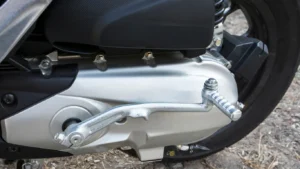If your car won’t start, you may get frustrated multiple times. Your garage-parked car may not start. There are many reasons a card won’t start, but I can help.
I have sixteen reasons a car won’t start. Follow these steps to solve the problem.
16 Reasons Why is My Car Not Starting?
Your car may not start for many reasons. Common causes:
Remember that diagnosing the cause of your car not starting can be complicated and require specialised tools and knowledge. For accurate diagnosis and repair, consult a professional mechanic.
1. Dead battery
The battery powers the starter motor, ignition system, and other electrical components. If the battery dies, the car won’t start.
Common battery failure causes:
Age:
Typically, car batteries have a lifespan of between three and five years. They eventually fail as they lose the ability to store a charge over time.
Parasitic efflux:
Over time, leaving an electrical device, such as a light or accessory, on when the automobile is turned off will drain the battery.
defective alternator:
During operation, the alternator is responsible for charging the battery. If it fails, the battery won’t charge and dies.
Corroded or loose connections:
Inadequate electrical connections, particularly at the battery terminals, might prohibit the battery from charging or supplying power to the vehicle’s electrical systems.
Extreme temperatures:
Excessive heat or cold can significantly impact the performance and lifespan of a battery.
Human error:
Leaving lights or accessories on inadvertently when the vehicle is turned off can drain the battery.
If you believe that your car’s battery is dead, you can attempt to jump-start it using another vehicle with a functional battery or a portable jump-starter. If the vehicle starts after being jump-started, it is likely that the battery was at fault. The battery must be inspected and, if necessary, changed to prevent future starting issues. In addition, have the charging system, particularly the alternator, inspected to ensure proper operation.
2. Bad starter
A defective starter is a typical cause of a vehicle’s inability to start. During the initial ignition procedure, the starting motor is responsible for rotating the engine. When the key is turned or the start button is pressed, the starter motor engages the engine’s flywheel, forcing it to revolve and initiating combustion. The engine won’t start if the starter motor is broken.
Among the symptoms of a defective starting motor are:
There is no response or clicking sound when the key is turned or the start button is pressed: A malfunctioning starter solenoid or worn internal components might prevent the starter motor from engaging, resulting in no reaction or a clicking sound when the vehicle is attempted to be started.
Slow rotation:
If the starter motor fails, it may turn the engine slowly, making it hard to start.
Recurrent overheating of the starting motor:
A starter motor that repeatedly overheats or has a burning odor may be experiencing internal wear or damage.
Problems with intermittent starting:
A failed starter motor may cause the vehicle to start intermittently, suggesting an intermittent starter problem.
Grinding noise:
A grinding sound when trying to start the car may indicate that the starter’s gear is not properly engaging with the engine’s flywheel.
If you suspect a faulty starter motor, you must have a professional mechanic diagnose and repair the issue. Replacing a faulty starter motor usually involves removing the old starter, installing a new one, and testing the starting mechanism.
3. Faulty alternator
Another reason a car won’t start or run is a bad alternator. The alternator powers the engine and charges the battery. If the alternator fails, the battery dies and the car won’t start.
Among the signs of a malfunctioning alternator are:
Caution indicator on the dash:
When the charging system fails, most cars have a dashboard warning light that looks like a battery.
Dim headlights and interior lighting:
Headlights and interior lights may dim if the alternator is underpowered, especially when other electrical accessories are on.
Batteries that are either weak or dead:
A malfunctioning alternator might result in a weak or dead battery since it does not recharge the battery when the engine is running.
Inability to start or frequent stalling:
Insufficient power from the alternator may result in trouble starting the vehicle or frequent stalling, especially at low speeds or idle.
Weird noises:
Due to worn or broken internal components, a malfunctioning alternator may emit unusual sounds, such as a whining or grinding sound.
A malfunctioning alternator may overheat or have a short circuit, resulting in a burning odor or even smoke.
A skilled mechanic must diagnose and repair an alternator problem. A mechanic will usually check the alternator, battery, and cabling to find the problem. If the alternator is defective, it must be replaced. The mechanic will test the charging system after fixing it.
4. Fuel delivery issues
Inadequate fuel distribution can potentially prevent a vehicle from starting or reduce engine performance. Fuel is transported from the tank to the engine, where it is mixed with air and ignited to generate power. Any issue with fuel supply can result in a circumstance where the engine will not start or perform poorly.
Typical problems with fuel delivery include:
Faulty fuel pump:
The fuel pump transfers gasoline from the tank to the engine. The engine may not start if the fuel pump fails or weakens.
Clogged fuel filter:
Before the fuel reaches the engine, the fuel filter assists in removing impurities. Over time, the filter might become clogged, preventing the engine from starting by reducing gasoline flow.
Fuel injector problems:
Injectors spray gasoline into the combustion chamber of a motor. If the injectors become soiled, clogged, or malfunction electronically, they can result in insufficient fuel supply, leading to a no-start scenario or poor engine performance.
Faulty fuel pressure regulator:
The fuel pressure regulator optimises fuel pressure. A defective regulator can create excessive or insufficient fuel pressure, leading to engine starting issues or poor performance.
Fuel line issues:
Broken, leaking, or obstructed fuel lines can restrict gasoline flow, preventing the engine from obtaining the required fuel to start and operate.
Contaminated or poor-quality fuel:
Water, grit, and other pollutants in the fuel can interrupt the combustion process, resulting in engine starting difficulties and poor performance.
If you suspect gasoline delivery problems, it is crucial to have a skilled mechanic analyze and remedy the issue. A mechanic will inspect the fuel pump, fuel filter, fuel injectors, fuel lines, and fuel pressure regulator and run diagnostic tests to find the problem. Depending on the situation, fuel flow to the engine may be restored by either cleaning or replacing components.
5. Ignition system issues
Vehicles with ignition system issues may not start or perform poorly. The ignition system sparks the air-fuel mixture in the combustion chamber, generating power. Engines may not start or run if the ignition system fails.
Typical ignition system problems include:
defective ignition switch:
When the key is turned or the start button is depressed, the ignition switch supplies power to the starter motor and other components. A faulty ignition switch may prevent power from being supplied, preventing the vehicle from starting.
Used or faulty spark plugs:
Spark plugs produce the spark that ignites the mixture of air and gasoline in an engine. Over time, spark plugs can get worn, fouled, or damaged, resulting in a weak or nonexistent spark that prevents the engine from starting or causes it to perform badly.
faulty ignition coil or group of coils:
The ignition coil converts battery current into spark-igniting high-voltage current. A malfunctioning ignition coil or coil pack may cause a weak or nonexistent spark, preventing the engine from starting.
Ignition control module (ICM) or engine control module (ECM) malfunction:
These electronic components regulate many parts of the ignition system, such as the timing and duration of the spark. A defective ICM or ECM can result in problems with the ignition system, preventing the engine from starting or operating normally.
Worn or deteriorated distributor components (in older vehicles):
In older automobiles with distributor-based ignition systems, faults with the distributor cap, rotor, or internal components can prevent the engine from starting and cause ignition problems.
Incorrect crankshaft or camshaft position sensors:
These sensors assist the engine control module (ECM) in determining the proper ignition timing. A defective sensor might interfere with the timing of the spark, preventing the engine from starting or operating normally.
If you suspect problems with the ignition system, you must get the issue checked and repaired by a competent mechanic. A mechanic will test the ignition system’s spark plugs, ignition coils, ignition control module, and cabling to find the problem. Depending on the issue, repairs may entail cleaning or replacing components in order to restore ignition system functionality.
6. Security system or immobilizer issues
As a theft deterrent, security system or immobilizer faults can keep a vehicle from starting. Frequently, modern vehicles are equipped with sophisticated security systems or immobilizers that interact with the vehicle’s key and other electrical components. A malfunctioning security system or immobilizer can prevent the vehicle from starting.
Frequent problems with security systems and immobilizers include:
Unidentified key:
The vehicle’s security system may not recognize the key owing to a broken or worn-out key, an issue with the key’s chip or transmitter, or a system failure. The immobilizer will prevent the vehicle from starting in this instance.
Faulty immobilizer module or antenna:
When the key is close to the vehicle, the immobilizer module and antenna are responsible for recognizing the key’s unique signal. A malfunctioning module or antenna may prevent the security system from recognizing the key, so stopping the vehicle from starting.
Wiring damage or disconnection:
Wiring problems associated with the security system or immobilizer, such as broken or disconnected cables, might render the system inoperable and prevent the vehicle from starting.
Dead remote key battery:
In certain instances, a dead battery in the key fob can prevent the vehicle’s security system from recognizing the key, resulting in an inoperable vehicle.
Problems with aftermarket security systems:
The factory immobiliser or other electrical systems may be interfered with by an aftermarket security system, preventing the vehicle from starting.
If you suspect problems with your vehicle’s security system or immobilizer, you must get the issue assessed and repaired by a skilled mechanic or a trained car locksmith. Typically, a mechanic or locksmith will evaluate the different security system or immobilizer components, such as the key, immobilizer module, antenna, and related cabling, and conduct diagnostic tests to find the main cause of the problem. Repairs may entail reprogramming the key, replacing components, or resolving wiring faults, depending on the cause of the malfunction.
7. Engine mechanical problems
Mechanical issues with the engine might also prevent a vehicle from starting or lead it to perform poorly. Any failure or malfunction in the engine’s mechanical components can result in an inability to start or other performance problems.
Typical engine mechanical issues include:
Broken timing chain or belt:
The timing belt or chain synchronizes the camshaft(s) and crankshaft of the engine. The engine’s internal components can clash if the belt or chain breaks or slips, inflicting significant damage and preventing the engine from starting.
Seized engine:
Lack of lubrication, overheating, or internal component failure can cause a motor to seize. When a motor seizes, its internal components lock together, preventing the engine from turning over and starting.
Bent or damaged valves:
Valves control engine air, fuel, and exhaust flow. If the valves get deformed or damaged, typically owing to a broken timing belt or chain, the engine may not be able to start or operate properly.
Failed head gasket:
The head gasket seals the combustion chambers, oil passageways, and coolant passages of the engine. A burst head gasket can allow coolant or oil to seep into the combustion chambers or mix with one another, resulting in engine overheating, poor performance, or a circumstance where the engine will not start.
Piston or cylinder damage:
Sometimes caused by detonation, damage to the engine’s pistons or cylinders can result in a loss of compression, stopping the engine from starting or reducing its performance.
Damaged or worn engine bearings:
Bearings within an engine facilitate the spinning of the crankshaft and camshaft. Worn or damaged bearings can cause excessive friction, noise, and engine failure or inability to start.
If you believe that your engine has technical issues, you must have the problem assessed and repaired by a skilled mechanic. To find the problem, a technician may perform compression, leak-down, or visual tests. Repairs may include fixing damaged parts, rebuilding the engine, or replacing it.
8. Faulty sensors
Faulty sensors can also cause a car not to start or result in poor engine performance. Modern vehicles rely on various sensors to monitor and control different aspects of the engine and other systems. The engine may not start if a sensor fails or sends incorrect data to the engine control module (ECM).
Common faulty sensors that can cause starting issues include:
Crankshaft position sensor:
The crankshaft position sensor tracks its position and speed. The ECM uses this information to determine the correct timing for ignition and fuel injection. If this sensor fails, the engine may not start or could stall while running.
Camshaft position sensor:
The camshaft position sensor monitors the position of the camshaft(s) and helps the ECM determine the correct timing for fuel injection and ignition. A faulty camshaft position sensor can cause the engine not to start, stall, or run poorly.
Mass air flow (MAF) sensor:
The MAF sensor measures the volume of air entering the engine, which the ECM uses to calculate the proper air-fuel mixture. A faulty MAF sensor can cause incorrect air-fuel ratios, leading to poor engine performance, stalling, or a no-start condition.
Engine coolant temperature sensor:
Engine coolant temperature is monitored by the sensor.The ECM uses this information to adjust the air-fuel mixture, ignition timing, and cooling fan operation. A faulty sensor can cause starting issues, particularly in cold weather, and affect engine performance.
Throttle position sensor:
The ECM receives throttle position data from the throttle position sensor. A malfunctioning sensor can cause poor engine performance, stalling, or a no-start condition.
Oxygen sensor:
The oxygen sensor monitors the levels of unburned oxygen in the exhaust, helping the ECM adjust the air-fuel mixture for optimal efficiency and emissions. While a faulty oxygen sensor typically doesn’t prevent a car from starting, it can cause poor performance, increased fuel consumption, and emissions issues.
If you suspect faulty sensors are causing your car not to start or run poorly, it’s essential to have the problem diagnosed and repaired by a professional mechanic. A mechanic will typically use diagnostic equipment to read trouble codes from the ECM, which can help pinpoint the issue. Depending on the problem, repairs might involve cleaning or replacing the faulty sensor(s) to restore proper engine operation.
9. Damaged or worn-out key
In vehicles with an immobiliser or security system that requires a specific key to start the engine, a damaged or worn-out key can prevent the car from starting. Over time, the key’s physical shape may become worn, or the internal electronics, such as the transponder chip or transmitter, may malfunction.
Common issues with damaged or worn-out keys include:
Difficulty turning the key in the ignition:
If the key’s shape is worn or damaged, it may not engage the lock cylinder properly, making it hard to turn or start the car.
Security system or immobilizer not recognizing the key:
The car may not start if the key’s transponder chip or transmitter is damaged or malfunctioning.
Intermittent starting issues:
A partially damaged key or a key with intermittent electronic issues may cause the car to start sometimes and not others.
Broken key:
In some cases, a key may become so worn or damaged that it breaks, either inside the lock cylinder or outside of it. A broken key will prevent the car from starting.
If you suspect a damaged or worn-out key is causing your car not to start, it’s essential to address the issue to restore proper vehicle operation. Depending on the situation, you may need to:
Obtain a new key:
Contact your local dealership or a specialized auto locksmith to obtain a new key. They can cut and program a new key based on your vehicle’s specific requirements.
Repair the key:
In some cases, a damaged key can be repaired. A specialized auto locksmith may be able to replace damaged internal components or reprogram the key.
Address the lock cylinder issue:
A locksmith or mechanic can replace or repair a damaged lock cylinder.
10. Transmission range sensor
A transmission range sensor, also known as a neutral safety switch, park/neutral position (PNP) switch, or gear position sensor, is an essential component in automatic transmission vehicles. The engine control module (ECM) or gearbox control module (TCM) receives the gear selection (Park, Reverse, Neutral, or Drive) (TCM). The transmission range sensor serves multiple purposes, including preventing the vehicle from starting in any gear other than Park or Neutral for safety reasons.
If the transmission range sensor is malfunctioning, it can cause issues with starting your car. Common symptoms of a faulty transmission range sensor include:
No-start condition:
If the transmission range sensor fails or provides incorrect information, the ECM or TCM may not allow the engine to start, as it cannot confirm that the vehicle is in Park or Neutral.
Starting in the wrong gear:
In some cases, a faulty transmission range sensor may allow the engine to start in an incorrect gear, such as Reverse or Drive, which can be dangerous.
Erratic shifting or transmission performance:
A faulty transmission range sensor can also cause shifting problems or erratic transmission performance, as the TCM may receive incorrect information about the selected gear.
Check engine light or warning indicators:
A malfunctioning transmission range sensor may trigger a check engine light or other warning indicators on the dashboard related to the transmission system.
If you suspect a faulty transmission range sensor is causing your car not to start or creating other issues, it’s essential to have the problem diagnosed and repaired by a professional mechanic. A mechanic will typically inspect the transmission range sensor, related wiring, and perform diagnostic tests to determine the root cause of the issue. Depending on the problem, repairs might involve cleaning, adjusting, or replacing the transmission range sensor to restore proper vehicle operation.
11. Clutch safety switch
Manual gearbox vehicles have a safety feature called a clutch safety switch. The switch ensures that the clutch pedal is fully depressed before the engine can be started. This prevents the car from lurching forward or stalling when the engine is started in gear.
If the clutch safety switch is malfunctioning, it can cause issues with starting your car. Common symptoms of a faulty clutch safety switch include:
No-start condition:
Even with the clutch pedal fully depressed, the engine control module (ECM) may not start the engine if the clutch safety switch fails or provides incorrect information.
Intermittent starting issues:
A partially malfunctioning clutch safety switch may cause the car to start sometimes and not others, depending on the switch’s condition and how it’s making contact.
Engine starts without depressing the clutch:
In some cases, a faulty clutch safety switch may allow the engine to start without the clutch pedal being fully depressed, which can be dangerous.
If you suspect a faulty clutch safety switch is causing your car not to start or creating other issues, it’s essential to have the problem diagnosed and repaired by a professional mechanic. A mechanic will typically inspect the clutch safety switch, related wiring, and perform diagnostic tests to determine the root cause of the issue. Depending on the problem, repairs might involve cleaning, adjusting, or replacing the clutch safety switch to restore proper vehicle operation.
12. Poor electrical connections
Poor electrical connections can cause a car not to start or lead to various performance issues. Electrical connections are crucial for transmitting power and signals between different components in a vehicle. Corroded, loose, or damaged connections can disrupt electrical current or signal transmission.
Common issues related to poor electrical connections include:
No-start condition:
If a poor electrical connection affects the flow of power to essential starting components, such as the battery, starter motor, or ignition system, the engine may not start.
Intermittent starting or performance issues:
Loose or corroded connections can cause intermittent electrical issues, leading to occasional starting problems or poor engine performance.
Warning lights or error codes:
Poor electrical connections can cause sensors or other electronic components to send incorrect signals or lose communication with the engine control module (ECM), potentially triggering warning lights or error codes.
Dead battery or charging issues:
If poor electrical connections affect the battery or charging system, the battery may not charge properly or could become drained, resulting in a no-start condition.
Component failures:
Poor electrical connections can damage sensors, relays, and motors.
It’s crucial to have a mechanic diagnose and fix poor electrical connections if you think they’re causing car problems. A mechanic checks the vehicle’s wiring, connectors, and related components for corrosion, damage, and loose connections. Repairs may include cleaning or replacing connectors, fixing wiring, or fixing other issues to restore electrical function.
13. Blown fuses or relay issues
Blown fuses or relays can prevent a car from starting or affect performance. Fuses and relays protect electrical circuits and components from excessive current or control current to specific components in a vehicle’s electrical system.
Common issues related to blown fuses or relay problems include:
No-start condition:
If a fuse or relay that is responsible for providing power to essential starting components, such as the fuel pump, ignition system, or starter motor, is blown or malfunctioning, the engine may not start.
Intermittent starting or performance issues:
A failing relay or a fuse with an intermittent connection can cause occasional starting problems or poor engine performance.
Loss of power to specific components:
Blown fuses or faulty relays can cause a loss of power to individual components or systems, such as the fuel pump, cooling fan, headlights, or other accessories.
Warning lights or error codes:
Blown fuses or relay issues can cause sensors or other electronic components to lose power or communication with the engine control module (ECM), potentially triggering warning lights or error codes.
To diagnose and fix blown fuses or relay issues, follow these steps:
Locate the fuse and relay box(es) in your vehicle. These are under the hood, near the battery, or under the dashboard.
Refer to your owner’s manual or a fuse box diagram to identify the specific fuses and relays associated with the components or systems causing issues.
Visually inspect the fuses for any signs of damage or a blown fuse (a broken or melted filament). Replace any blown fuses with new ones of the same amperage rating.
Test the relays using a multimeter or by swapping them with known good relays of the same type. Replace faulty relays.
If you can’t diagnose or fix blown fuses or relays, a mechanic should do it. A mechanic will inspect the vehicle’s fuses, relays, and related components for damage and run tests to find the problem. Repairs may involve replacing fuses or relays, fixing the cause of the fuses blowing, or fixing wiring or components.
14. Flooded engine
A flooded engine occurs when too much fuel enters the combustion chambers unignited. Excess fuel can saturate spark plugs, making combustion difficult. Flooded engines are more common in carbureted engines, but fuel-injected engines can flood under certain conditions, such as multiple cold-weather starts.
Symptoms of a flooded engine may include:
No-start condition:
The engine may crank but not start due to the inability of the spark plugs to ignite the air-fuel mixture.
Strong smell of gasoline:
A strong petrol smell near the engine or exhaust indicates excess unburned fuel.
Wet or fouled spark plugs: Removing the spark plugs may reveal that they are wet with fuel or covered in black soot, indicating a flooding issue.
To address a flooded engine, follow these steps:
Remove the fuel-saturated spark plugs:
Take out the spark plugs and clean them with a soft cloth or replace them if they are heavily fouled.
Clear the excess fuel:
Crank the engine for 10-15 seconds with the spark plugs out and the accelerator pedal fully depressed. This allows fresh air to enter the cylinders and helps to evaporate the excess fuel.
Reinstall the spark plugs:
Reinstall the cleaned or new spark plugs, ensuring they are properly gapped and tightened.
Attempt to start the engine:
Try starting the engine again without pressing the accelerator pedal. If the engine starts, idle it for a few minutes to clear the combustion chambers and exhaust system of excess fuel.
If the engine still does not start after attempting these steps, or if the issue recurs frequently, it’s essential to have the problem diagnosed and repaired by a professional mechanic. To prevent future flooding, fix the fuel injection or ignition system.
15. Contaminated or wrong fuel
Using contaminated or wrong fuel in your vehicle can cause starting issues or lead to engine damage. Different fuels have specific properties that are crucial for the proper operation of a vehicle’s engine. Fuel with water, dirt, or other contaminants can cause many issues.
Common issues related to contaminated or wrong fuel include:
No-start condition:
Contaminated fuel or the wrong type of fuel may not ignite properly in the engine, preventing the vehicle from starting.
Poor engine performance:
Contaminated fuel or the wrong type of fuel can lead to poor engine performance, including reduced power, hesitation, stalling, or misfires.
Engine damage:
Due to the differences in combustion properties and lubrication requirements, using the wrong fuel, such as petrol in a diesel engine, can damage the engine.
Fuel system damage:
The fuel pump, injectors, and filter can be damaged by contaminated fuel, causing performance issues or a no-start condition.
To avoid damage, address fuel contamination issues immediately. Situations may require:
Drain the fuel tank:
Have a professional mechanic or a specialized service drain the contaminated or wrong fuel from your vehicle’s fuel tank.
Replace the fuel filter:
After draining the fuel tank, replace the fuel filter because contaminated fuel can clog it.
Clean or replace fuel system components:
The fuel pump and injectors may be damaged by contaminated or incorrect fuel. Clean or replace these parts.
Refill the tank with the correct fuel: After addressing the issue, refill your vehicle’s fuel tank with the correct type of fuel specified by the manufacturer.
If your vehicle is experiencing ongoing issues after using contaminated or wrong fuel, it’s essential to have the problem diagnosed and repaired by a professional mechanic. They will inspect the vehicle’s fuel and engine systems and perform any necessary repairs to restore proper vehicle operation.
16. Extreme weather conditions
Extreme weather conditions can cause a car not to start or lead to various performance issues and extreme cold and heat can damage vehicle components, making the engine hard to start.
Common issues related to extreme weather conditions include:
Cold weather:
a. Thickened engine oil: In extremely cold temperatures, engine oil can thicken and make it hard to start.
b. Reduced battery capacity: Cold weather can significantly reduce a battery’s capacity and ability to deliver the necessary current to start the engine.
c. Fuel delivery problems: Cold temperatures can cause fuel lines to freeze or thicken fuel, leading to issues with fuel delivery to the engine.
d. Carburetor icing: In older vehicles with carburetors, ice can form inside the carburetor, blocking the proper flow of air and fuel into the engine.
Hot weather:
a. Overheating: Overheating can damage the engine or make it hard to start in hot weather.
b. Vapor lock: High temperatures can cause fuel to vaporize within the fuel lines or fuel system, creating a vapor lock that prevents the proper flow of fuel to the engine.
c. Battery issues: Hot weather can also negatively impact battery performance, reducing its capacity and shortening its lifespan.
To address starting issues related to extreme weather conditions, consider the following steps:
Maintain your vehicle:
Make sure your car is ready for the heat by keeping up with routine maintenance like oil changes, coolant flushes, and battery checks.
Use the proper engine oil: Using the appropriate engine oil with the correct viscosity for your vehicle and climate can help prevent issues with thickened oil in cold weather.
Insulate your battery:
Consider using a battery blanket or insulation to help maintain the battery’s capacity in cold temperatures.
Use fuel additives:
In cold weather, using a fuel additive designed to prevent fuel line freezing can help ensure proper fuel delivery to the engine.
Park in a sheltered location:
To avoid extreme temperatures and direct sunlight, park your car in a garage or shaded area.
A professional mechanic should diagnose and fix your vehicle’s starting or performance issues if extreme weather persists. They’ll check the vehicle’s systems and components for problems and fix them.
Conclusion
In conclusion, electrical, mechanical, and environmental factors can prevent a car from starting. A dead battery, faulty starter, bad alternator, fuel delivery issues, ignition system issues, security system or immobiliser issues, engine mechanical issues, faulty sensors, damaged or worn-out keys, gearbox range sensor issues, clutch safety switch issues, poor electrical connections, blown fuses or relay issues, a flooded engine, contaminated or wrong fuel, and extreme weather conditions are common causes of a car not starting.
Starting issues must be diagnosed and fixed quickly to avoid further damage or inconvenience. Consult a professional mechanic to diagnose and repair the issue if you’re unsure. Regular maintenance can also prevent many of these issues and keep your car running smoothly in all conditions.






